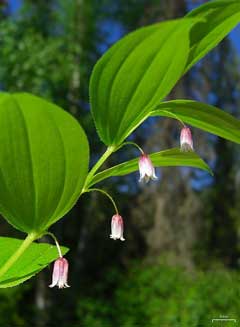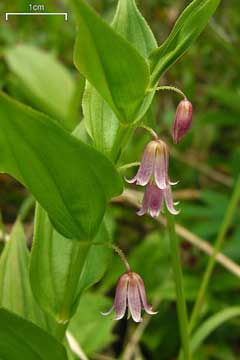 |
|
http://www.flickr.com/photos/7147684@N03 |
 |
| http://www.flickr.com/photos/7147684@N03 |
Translate this page:
Summary
Streptopus roseus Michx. is a synonym of Streptopus lanceolatus (Aiton) Reveal
Physical Characteristics

 Streptopus roseus is a PERENNIAL growing to 0.5 m (1ft 8in) by 0.3 m (1ft).
Streptopus roseus is a PERENNIAL growing to 0.5 m (1ft 8in) by 0.3 m (1ft).
See above for USDA hardiness. It is hardy to UK zone 3. It is in flower from May to July, and the seeds ripen from September to October. The species is hermaphrodite (has both male and female organs).
Suitable for: light (sandy) and medium (loamy) soils. Suitable pH: mildly acid, neutral and basic (mildly alkaline) soils. It can grow in full shade (deep woodland) or semi-shade (light woodland). It prefers moist soil.
UK Hardiness Map
US Hardiness Map
Synonyms
S. curvipes. S. lanceolatus (Aiton) Reveal
Plant Habitats
Woodland Garden Dappled Shade; Shady Edge; not Deep Shade;
Edible Uses
Edible Parts: Fruit Leaves Shoots
Edible Uses:
Young leaves and shoots are added to salads to impart a cucumber flavour[183]. They can also be cooked and used as greens[172, 257]. Fruit - raw or cooked. A sweetish flavour[207], though it is said to be cathartic if eaten in quantity[183, 207], especially if you have not eaten this fruit before[K]. A watermelon flavour[172]. The fruit is about 12mm in diameter[235].
References More on Edible Uses
Medicinal Uses
Plants For A Future can not take any responsibility for any adverse effects from the use of plants. Always seek advice from a professional before using a plant medicinally.
Cathartic Diaphoretic Ophthalmic Pectoral Tonic Women's complaints
The fruit is cathartic[172, 207]. An infusion of the roots has been used in the treatment of a fallen womb[257]. A cough syrup can be made from the root[257]. A poultice of the steeped root has been applied to the eyes in the treatment of sties[257]. The flowers are diaphoretic[257]. They can be used to induce sweating in the treatment of colds and fevers. The plant is tonic[257]. An infusion of the plant has been used in the treatment of coughs[257].
References More on Medicinal Uses
The Bookshop: Edible Plant Books
Our Latest books on Perennial Plants For Food Forests and Permaculture Gardens in paperback or digital formats.

Edible Tropical Plants
Food Forest Plants for Hotter Conditions: 250+ Plants For Tropical Food Forests & Permaculture Gardens.
More

Edible Temperate Plants
Plants for Your Food Forest: 500 Plants for Temperate Food Forests & Permaculture Gardens.
More

More Books
PFAF have eight books available in paperback and digital formats. Browse the shop for more information.
Shop Now
Other Uses
References More on Other Uses
Cultivation details
Requires a cool leafy soil in shade or partial shade[187]. Thrives in a moist light soil containing organic matter[1]. Hardy to at least -20°c. A very ornamental plant[1]. For polyculture design as well as the above-ground architecture (form - tree, shrub etc. and size shown above) information on the habit and root pattern is also useful and given here if available. The plant growth habit is a clumper with limited spread [1-2]. The root pattern is rhizomatous with underground stems sending roots and shoots along their length [1-2].
References Carbon Farming Information and Carbon Sequestration Information
Temperature Converter
Type a value in the Celsius field to convert the value to Fahrenheit:
Fahrenheit:
The PFAF Bookshop
Plants For A Future have a number of books available in paperback and digital form. Book titles include Edible Plants, Edible Perennials, Edible Trees,Edible Shrubs, Woodland Gardening, and Temperate Food Forest Plants. Our new book is Food Forest Plants For Hotter Conditions (Tropical and Sub-Tropical).
Shop Now
Plant Propagation
Seed - best sown in a cold frame as soon as it is ripe in the summer[200]. Sow stored seed in a cold frame as soon as it is received. The seed, especially if it has been stored, can be very slow to germinate, sometimes taking 18 months or more. Prick out the seedlings into individual pots once they are large enough to handle and grow them on in a shady part of the greenhouse or cold frame. It will normally take 2 or more growing seasons before the roots are large enough to plant out - this is best done when the plant is dormant in the autumn. Division as the plant comes into growth in early spring. Larger divisions can be planted out direct into their permanent positions. We have found that it is best to pot up smaller divisions and grow them on in light shade in a greenhouse or cold frame for their first year, planting them out in the following spring.
Other Names
If available other names are mentioned here
Rose twisted stalk, rosybells, rose mandarin, scootberry, liverberry, rose-bellwort.
Native Range
NORTHERN AMERICA: Canada, Québec, Nova Scotia, Ontario, Prince Edward Island, New Brunswick, Newfoundland and Labrador, Alberta, Manitoba, British Columbia, United States, Alaska, Connecticut, Maine, Massachusetts, Michigan, New Hampshire, New Jersey, New York, Ohio, Pennsylvania, Rhode Island, Vermont, West Virginia, Iowa, Minnesota, Wisconsin, Montana, Oregon, Washington, Kentucky, Maryland, North Carolina, Tennessee, Virginia,
Weed Potential
Right plant wrong place. We are currently updating this section.
Please note that a plant may be invasive in one area but may not in your area so it's worth checking.
Conservation Status
IUCN Red List of Threatened Plants Status :

Growth: S = slow M = medium F = fast. Soil: L = light (sandy) M = medium H = heavy (clay). pH: A = acid N = neutral B = basic (alkaline). Shade: F = full shade S = semi-shade N = no shade. Moisture: D = dry M = Moist We = wet Wa = water.
Now available:
Food Forest Plants for Mediterranean Conditions
350+ Perennial Plants For Mediterranean and Drier Food Forests and Permaculture Gardens.
[Paperback and eBook]
This is the third in Plants For A Future's series of plant guides for food forests tailored to
specific climate zones. Following volumes on temperate and tropical ecosystems, this book focuses
on species suited to Mediterranean conditions—regions with hot, dry summers and cool, wet winters,
often facing the added challenge of climate change.
Read More
Expert comment
Author
Michx.
Botanical References
60200270
Links / References
For a list of references used on this page please go here
Readers comment
| Add a comment |
|
If you have important information about this plant that may help other users please add a comment or link below. Only comments or links that are felt to be directly relevant to a plant will be included. If you think a comment/link or information contained on this page is inaccurate or misleading we would welcome your feedback at [email protected]. If you have questions about a plant please use the Forum on this website as we do not have the resources to answer questions ourselves.
* Please note: the comments by website users are not necessarily those held by PFAF and may give misleading or inaccurate information.
To leave a comment please Register or login here All comments need to be approved so will not appear immediately.
|
Subject : Streptopus roseus
|
|
|
|